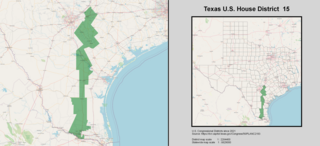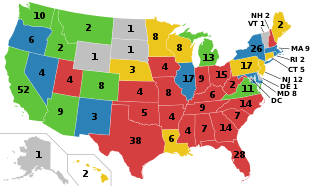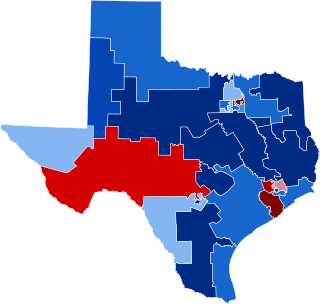Related Research Articles

The Virginia General Assembly is the legislative body of the Commonwealth of Virginia, the oldest continuous law-making body in the Western Hemisphere, and the first elected legislative assembly in the New World. It was established on July 30, 1619.
Redistricting in the United States is the process of drawing electoral district boundaries. For the United States House of Representatives, and state legislatures, redistricting occurs after each decennial census.

The U.S. state of New York contains 26 congressional districts. Each district elects one member of the United States House of Representatives to represent it.

The 1982 United States House of Representatives elections was an election for the United States House of Representatives held on November 2, 1982, to elect members to serve in the 98th United States Congress. They occurred in the middle of President Ronald Reagan's first term, whose popularity was sinking due to economic conditions under the 1982 recession. The President's Republican Party lost seats in the House, which could be viewed as a response to the President's approval at the time. Unlike most midterm election cycles, the number of seats lost—26 seats to the Democratic Party—was a comparatively large swap. It included most of the seats that had been gained the previous election, cementing the Democratic majority. Coincidentally, the number of seats the Democrats picked up (26), was the exact amount the Republicans would have needed to win the House majority. It was the first election held after the 1980 United States redistricting cycle.

Texas's 15th congressional district of the United States House of Representatives includes a thin section of the far south of the state of Texas. The district's current Representative is Republican Monica De La Cruz. Elected in 2022, de la Cruz is the first Republican and woman to represent the district.
Congressional districts, also known as electoral districts in other nations, are divisions of a larger administrative region that represent the population of a region in the larger congressional body. Countries with congressional districts include the United States, the Philippines, and Japan.

Oregon's 5th congressional district stretches from the Southeast corner of Portland through the eastern half of the Willamette Valley and then reaches across the Cascades to take in Sisters and Bend. It includes a sliver of Multnomah County, the majority of Clackamas County, the rural eastern portion of Marion County, most of Linn County, a very small section of southwest Jefferson County, and the populated northwest portion of Deschutes County. It was significantly redrawn when Oregon gained a 6th congressional district after the 2020 census.

Utah is divided into 4 congressional districts, each represented by a member of the United States House of Representatives. After the 2010 census, Utah gained one House seat, and a new map was approved by the state legislature and signed into law by Governor Gary Herbert.

In the United States, a redistricting commission is a body, other than the usual state legislative bodies, established to draw electoral district boundaries. Generally the intent is to avoid gerrymandering, or at least the appearance of gerrymandering, by specifying a nonpartisan or bipartisan body to comprise the commission drawing district boundaries.
Redistribution is the process by which electoral districts are added, removed, or otherwise changed. Redistribution is a form of boundary delimitation that changes electoral district boundaries, usually in response to periodic census results. Redistribution is required by law or constitution at least every decade in most representative democracy systems that use first-past-the-post or similar electoral systems to prevent geographic malapportionment. The act of manipulation of electoral districts to favour a candidate or party is called gerrymandering.

The following is a list of the ten congressional districts in the U.S. state of Washington. From the time that Washington Territory was formed in 1853, through statehood in 1889, Washington Territory elected an at-large non-voting Delegate to the United States House of Representatives. At different times in its history, the state of Washington has also elected one or more representatives At-large statewide. Washington gained its 10th district following reapportionment after the 2010 census.

Gerrymandering is the practice of setting boundaries of electoral districts to favor specific political interests within legislative bodies, often resulting in districts with convoluted, winding boundaries rather than compact areas. The term "gerrymandering" was coined after a review of Massachusetts's redistricting maps of 1812 set by Governor Elbridge Gerry noted that one of the districts looked like a mythical salamander.

The 2020 United States redistricting cycle is in progress following the completion of the 2020 United States census. In all fifty states, various bodies are re-drawing state legislative districts. States that are apportioned more than one seat in the United States House of Representatives are also drawing new districts for that legislative body.

The 1982 United States House of Representatives elections in Texas occurred on November 2, 1982, to elect the members of the state of Texas's delegation to the United States House of Representatives. Texas had twenty-seven seats in the House, up three from the 1970s, apportioned according to the 1980 United States census.

Redistricting in Wisconsin is the process by which boundaries are redrawn for municipal wards, Wisconsin State Assembly districts, Wisconsin State Senate districts, and Wisconsin's congressional districts. Redistricting typically occurs—as in other U.S. states—once every decade, usually in the year after the decennial United States census. According to the Wisconsin Constitution, redistricting in Wisconsin follows the regular legislative process, it must be passed by both houses of the Wisconsin Legislature and signed by the Governor of Wisconsin—unless the Legislature has sufficient votes to override a gubernatorial veto. Due to political gridlock, however, it has become common for Wisconsin redistricting to be conducted by courts. The 1982, 1992, and 2002 legislative maps were each enacted by panels of United States federal judges; the 1964 and 2022 maps were enacted by the Wisconsin Supreme Court.
The 2010 United States redistricting cycle took place following the completion of the 2010 United States census. In all fifty states, various bodies re-drew state legislative districts. States that are apportioned more than one seat in the United States House of Representatives also drew new districts for that legislative body. The resulting new districts were first implemented for the 2011 and 2012 elections.
The 2000 United States redistricting cycle took place following the completion of the 2000 United States census. In all fifty states, various bodies re-drew state legislative and congressional districts. States that are apportioned more than one seat in the United States House of Representatives also drew new districts for that legislative body. The resulting new districts were first implemented for the 2001 and 2002 elections, which saw Republicans add eight seats to their U.S. House majority, capture eight state legislative chambers and win a majority of state legislative seats for the first time in half a century.
The 1990 United States redistricting cycle took place following the completion of the 1990 United States census. In all fifty states, various bodies re-drew state legislative and congressional districts. States that are apportioned more than one seat in the United States House of Representatives also drew new districts for that legislative body. The resulting new districts were first implemented for the 1991 and 1992 elections, which saw Democrats lose nine seats from their U.S. House majority and lose sixteen state legislative chambers but continue to retain a majority of state legislative seats nationwide throughout the decade. To date, it is the last time that Democrats held a majority of state legislative seats throughout an entire census cycle.
The 1970 United States redistricting cycle took place following the completion of the 1970 United States census. In all fifty states, various bodies re-drew state legislative and congressional districts. States that are apportioned more than one seat in the United States House of Representatives also drew new districts for that legislative body. The resulting new districts were first implemented for the 1972 elections.
The 1960 United States redistricting cycle took place following the completion of the 1960 United States census. In all fifty states, various bodies re-drew state legislative and congressional districts. States that are apportioned more than one seat in the United States House of Representatives also drew new districts for that legislative body. Following the 1960 United States elections, control of redistricting was split between Democrats and Republicans s in 17 states. The resulting new districts were first implemented for the 1962 elections.
References
- ↑ Roberts, Steven V. (November 4, 1982). "DEMOCRATS REGAIN CONTROL IN HOUSE". The New York Times. ISSN 0362-4331 . Retrieved June 29, 2022.